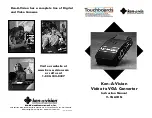
4
C H A P T E R 2
Cameras and Operating Systems
For the smaller models—especially the
Digital Elph (Ixus)
series—the
shutter mechanism consists of a simple mechanical shutter plus an elec-
tronic shutter. Because the circuitry for the electronic shutter requires
some space on the sensor chip, less sensor area is left for the light-sensitive
parts—resulting in a less than optimal signal-to- noise ratio compared to a
DSLR. Therefore, the top-of-the-range Powershot models, such as the
G-series, use a mechanical shutter in order not to sacrifice valuable sensor
real estate.
Similarly, the lenses of the low-cost cameras are not equipped with a
diaphragm but rather with an ND (neutral density) filter that is switched
on when the scene becomes too bright. Because the lens is always used at
full aperture, it is not possible to increase the depth of sharpness (DOF) by
stopping down with these cameras. Variations in brightness and shutter
speed are compensated for by the ND filter and by changing the sensor’s
sensitivity (ISO speed). Higher-priced cameras are equipped with a tradi-
tional diaphragm.
All Canon cameras are, of course, equipped with autofocus ( AF) and
automatic exposure ( AE) control. Newer models even have face detection.
Only the top-range models allow for manual control of focus, shutter
speed, aperture, and ISO. With the CHDK, manual control of focus and ex-
posure is achieved for all models—within the physical limits of the camera,
of course.
All Canon cameras are equipped with an internal flash unit. Some larger
cameras offer the option of connecting an external flash as well. Unfortu-
nately, not all cameras allow fine-tuned manual control of the flash power.
As a result, flash images can often look unnatural and flat. In many cases,
the flash is too bright. The CHDK allows a manual flash on all models with
three different power settings, resulting in more natural-looking flash
images.
All Canon cameras are equipped with a video function, in some cases an
HD video function. Because the camera’s image sensor has a much higher
resolution than a video frame, digital zoom
(Digital Converter)
can be uti-
lized to a certain degree for video shots without losing quality. In most
cases, the optical zoom is disabled during video shooting, as the zoom mo-
tor’s noise would ruin the soundtrack. With the CHDK, this behavior can be
overridden (for some cameras) and the optical zoom can be used while
shooting video (section 4.8). Some editing will be required, however, for the
soundtrack.
The built-in audio facility (microphone and audio digitizer) that is used
for the video soundtrack can be used for photos, too. Voice notes can be
attached to photos, or the camera can be utilized as a dictating machine.
Содержание Camera
Страница 1: ......
Страница 2: ...The Canon Camera Hackers Manual ...
Страница 3: ......
Страница 4: ...Berthold Daum The Canon Camera Hackers Manual Teach Your Camera New Tricks ...
Страница 19: ...10 CH APTER 2 Cameras and Operating Systems ...
Страница 25: ...16 CH APTER 3 ...
Страница 85: ...76 CH APTER 4 Teach Your Camera New Tricks ...
Страница 213: ...204 CH APTER 6 ...
Страница 253: ...244 AP PENDIX ...














































